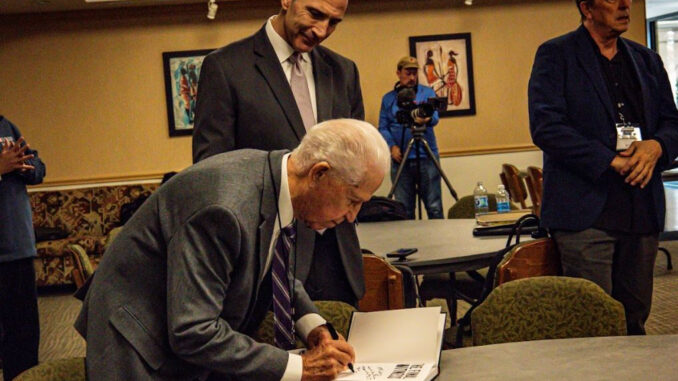
Zach Petroff & Naomi Girson | Opinions Editor & Staff Writer
Paul Landis’s voice began to shake when he started talking about what happened in Dallas on Nov. 22, 1963.
By the time he finished telling his story to a rapt audience in the Union Ballroom, it was clear the 88-year-old former Secret Service agent assigned to First Lady Jackie Kennedy was holding back tears.
“I see the grief and sadness there all the time,” Landis said. “It has gone through my mind and thinking about the family and the kids. What’s going to happen to them? It’s hard for me to really go back and share my feelings.”
After 60 years of silence on the subject and never being questioned by the Warren Commission, Landis’s recounting of the event at last week’s anniversary event challenged the official narrative of the John F. Kennedy assassination.
Landis was in the vehicle behind Kennedy’s limo during the Dallas Parade and saw the shots that killed President Kennedy and wounded the governor of Texas, John Connally.
“I saw that third shot hit the president in the head,” Landis said. “His head exploded, a mist of blood flowed into the air. I ducked to avoid getting splattered. I was that close.”
Landis was one of several key speakers featured at the 22nd Annual Forensic Science and Law’s speaker series “JFK Assissination at 60” symposium. The three-day, hybrid academic conference, which started on the evening of, Nov. 15, examined the forensic and cultural impact of the Kennedy assassination.
The symposium opened Wednesday evening with a reception and opening remarks from the Keynote Speaker, Barbara Perry, Professor in Presidential Studies at the University of Virginia’s Miller Center.
On Thursday the symposium was dedicated to the criminalistics, forensic science and medicine involved in the historic event. Friday, the symposium explored the history, politics and the impact of the assassination.
With the aid of experts in the field of physics, forensics, law and journalism, this year’s symposium made the case for “Why the Kennedy assassination still matters?”
Audience members consisted of students like Max Gleason and Joe Randolph who both attend University of Notre Dame. Gleason and Randolph said they both have learned about the assassination in class, but the event provided them with a bigger picture.
“I actually focused on the different scientific and forensic aspects for my research for the class,” Randolph said. “It’s just really cool that I’m seeing a lot of people that I actually quoted. It’s kind of crazy.”
Author of “Last Second in Dallas” Josiah Thompson shared his research on the case that Kennedy sustained two bullet wounds to the head, greatly increasing the chances of their being a second shooter.
“It’s the only scenario that meets the constraints of medical ballistics acoustics,” Thompson said. “I think, over time, this thesis will be accepted by almost everybody working on the assassination.”
In addition to Landis’ first-person retelling of the events that occurred in 1963 he also participated in a round table discussion hosted by Duquesne University President Ken Gormley.
“Paul Landis was not only a witness to the assassination, but he also revealed explosive new details about key evidence in his book,” Gormley said. “He states that he found this intact bullet in the limousine where Mrs. Kennedy had been sitting after the shooting and placed it on President Kennedy’s stretcher inside the hospital.”
Gormley and Landis first met in 2016, when former director of the Secret Service and Duquesne alumni, Lewis Merletti, suggested to Landis to meet with Gormley to discuss if he should publish his story.
“This is the exact same story that [Landis] recounted to me seven years ago,” Gormley said. “I found [Landis] to be sincere and credible.”
Friday, Jefferson Morley, an investigative journalist who has spent over three decades analyzing the circumstances around the assassination, spoke about the CIA’s involvement.
Morley said he does not believe the “official” story of the JFK murder and set out to find out what really happened that day in Dallas.
“This is our story, but this is a story that is unfinished and we are handing it off to the next generation,” Morley said during his opening remarks. “I really see my job is helping young people understand this story that happened long ago.”
Morley’s presentation included his investigation into the CIA’s involvement in the events surrounding the assassination while also questioning the validity of both President Johnson’s investigation and the Warren Commission.
According to Morley, four of the seven officials involved claimed Warren and Johnson’s investigations have inaccuracies.
The first official to go on record, CIA officer Jane Roman, spoke with Morley 31 years after the assassination. Her retelling of events, according to Morley, included the CIA’s involvement and understanding of Oswald’s activities leading up to Kennedy’s murder.
There were documents in circulation, with Oswald’s name and Roman’s signature on them, Morley said
“Roman herself admitted to signing off on information about the future accused assassin (Oswald),” said Morley.”[She] admitted that the information was false.”
Greg Adams and Dave Lentz who originally met at a JFK assassination conference in Dallas have been actively involved in the research and investigation into JFK’s assassination.
The self-titled “conspiracy theorists” attend JFK conferences as not just a hobby but as a way to shake off the stigma around conspiracy theorists.
Lentz said he believes it’s important for civilians to look into the circumstances surrounding the death of President Kennedy.
“There are thousands of people at our level, still interested in this, it shows that the truth does matter,” Lentz said. “We don’t like to be lied to about major events. We’re capable of handling the truth, we’re mature enough.”
Even 60 years later the death of the president continues to leave behind unanswered questions.
“It remains one of the greatest mysteries in American History,” said Gormley. “All of these years later, it’s astounding that it remains unresolved.”

